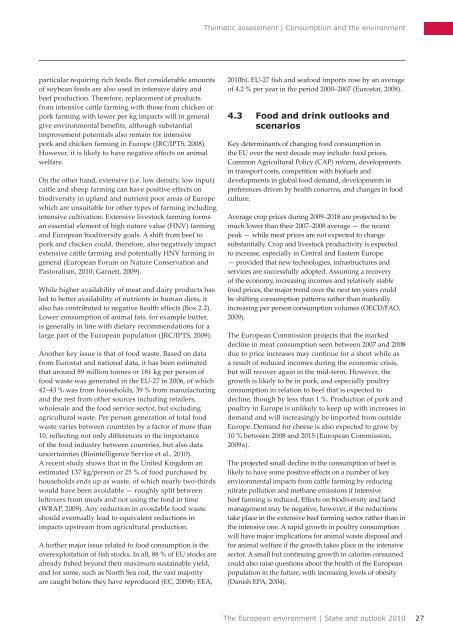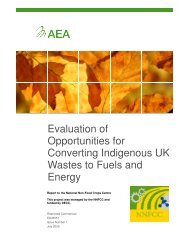Consumption and the environment (SOER2010) - European ...
Consumption and the environment (SOER2010) - European ...
Consumption and the environment (SOER2010) - European ...
Create successful ePaper yourself
Turn your PDF publications into a flip-book with our unique Google optimized e-Paper software.
Thematic assessment | <strong>Consumption</strong> <strong>and</strong> <strong>the</strong> <strong>environment</strong><br />
particular requiring rich feeds. But considerable amounts<br />
of soybean feeds are also used in intensive dairy <strong>and</strong><br />
beef production. Therefore, replacement of products<br />
from intensive cattle farming with those from chicken or<br />
pork farming with lower per kg impacts will in general<br />
give <strong>environment</strong>al benefits, although substantial<br />
improvement potentials also remain for intensive<br />
pork <strong>and</strong> chicken farming in Europe (JRC/IPTS, 2008).<br />
However, it is likely to have negative effects on animal<br />
welfare.<br />
On <strong>the</strong> o<strong>the</strong>r h<strong>and</strong>, extensive (i.e. low density, low input)<br />
cattle <strong>and</strong> sheep farming can have positive effects on<br />
biodiversity in upl<strong>and</strong> <strong>and</strong> nutrient poor areas of Europe<br />
which are unsuitable for o<strong>the</strong>r types of farming including<br />
intensive cultivation. Extensive livestock farming forms<br />
an essential element of high nature value (HNV) farming<br />
<strong>and</strong> <strong>European</strong> biodiversity goals. A shift from beef to<br />
pork <strong>and</strong> chicken could, <strong>the</strong>refore, also negatively impact<br />
extensive cattle farming <strong>and</strong> potentially HNV farming in<br />
general (<strong>European</strong> Forum on Nature Conservation <strong>and</strong><br />
Pastoralism, 2010; Garnett, 2009).<br />
While higher availability of meat <strong>and</strong> dairy products has<br />
led to better availability of nutrients in human diets, it<br />
also has contributed to negative health effects (Box 2.2).<br />
Lower consumption of animal fats, for example butter,<br />
is generally in line with dietary recommendations for a<br />
large part of <strong>the</strong> <strong>European</strong> population (JRC/IPTS, 2009).<br />
Ano<strong>the</strong>r key issue is that of food waste. Based on data<br />
from Eurostat <strong>and</strong> national data, it has been estimated<br />
that around 89 million tonnes or 181 kg per person of<br />
food waste was generated in <strong>the</strong> EU‐27 in 2006, of which<br />
42–43 % was from households, 39 % from manufacturing<br />
<strong>and</strong> <strong>the</strong> rest from o<strong>the</strong>r sources including retailers,<br />
wholesale <strong>and</strong> <strong>the</strong> food service sector, but excluding<br />
agricultural waste. Per person generation of total food<br />
waste varies between countries by a factor of more than<br />
10, reflecting not only differences in <strong>the</strong> importance<br />
of <strong>the</strong> food industry between countries, but also data<br />
uncertainties (Biointelligence Service et al., 2010).<br />
A recent study shows that in <strong>the</strong> United Kingdom an<br />
estimated 137 kg/person or 25 % of food purchased by<br />
households ends up as waste, of which nearly two-thirds<br />
would have been avoidable — roughly split between<br />
leftovers from meals <strong>and</strong> not using <strong>the</strong> food in time<br />
(WRAP, 2009). Any reduction in avoidable food waste<br />
should eventually lead to equivalent reductions in<br />
impacts upstream from agricultural production.<br />
A fur<strong>the</strong>r major issue related to food consumption is <strong>the</strong><br />
overexploitation of fish stocks. In all, 88 % of EU stocks are<br />
already fished beyond <strong>the</strong>ir maximum sustainable yield,<br />
<strong>and</strong> for some, such as North Sea cod, <strong>the</strong> vast majority<br />
are caught before <strong>the</strong>y have reproduced (EC, 2009b; EEA,<br />
2010b). EU‐27 fish <strong>and</strong> seafood imports rose by an average<br />
of 4.2 % per year in <strong>the</strong> period 2000–2007 (Eurostat, 2008).<br />
4.3 Food <strong>and</strong> drink outlooks <strong>and</strong><br />
scenarios<br />
Key determinants of changing food consumption in<br />
<strong>the</strong> EU over <strong>the</strong> next decade may include: food prices,<br />
Common Agricultural Policy (CAP) reform, developments<br />
in transport costs, competition with biofuels <strong>and</strong><br />
developments in global food dem<strong>and</strong>, developments in<br />
preferences driven by health concerns, <strong>and</strong> changes in food<br />
culture.<br />
Average crop prices during 2009–2018 are projected to be<br />
much lower than <strong>the</strong>ir 2007–2008 average — <strong>the</strong> recent<br />
peak — while meat prices are not expected to change<br />
substantially. Crop <strong>and</strong> livestock productivity is expected<br />
to increase, especially in Central <strong>and</strong> Eastern Europe<br />
— provided that new technologies, infrastructures <strong>and</strong><br />
services are successfully adopted. Assuming a recovery<br />
of <strong>the</strong> economy, increasing incomes <strong>and</strong> relatively stable<br />
food prices, <strong>the</strong> major trend over <strong>the</strong> next ten years could<br />
be shifting consumption patterns ra<strong>the</strong>r than markedly<br />
increasing per person consumption volumes (OECD/FAO,<br />
2009).<br />
The <strong>European</strong> Commission projects that <strong>the</strong> marked<br />
decline in meat consumption seen between 2007 <strong>and</strong> 2008<br />
due to price increases may continue for a short while as<br />
a result of reduced incomes during <strong>the</strong> economic crisis,<br />
but will recover again in <strong>the</strong> mid-term. However, <strong>the</strong><br />
growth is likely to be in pork, <strong>and</strong> especially poultry<br />
consumption in relation to beef that is expected to<br />
decline, though by less than 1 %. Production of pork <strong>and</strong><br />
poultry in Europe is unlikely to keep up with increases in<br />
dem<strong>and</strong> <strong>and</strong> will increasingly be imported from outside<br />
Europe. Dem<strong>and</strong> for cheese is also expected to grow by<br />
10 % between 2008 <strong>and</strong> 2015 (<strong>European</strong> Commission,<br />
2009a).<br />
The projected small decline in <strong>the</strong> consumption of beef is<br />
likely to have some positive effects on a number of key<br />
<strong>environment</strong>al impacts from cattle farming by reducing<br />
nitrate pollution <strong>and</strong> methane emissions if intensive<br />
beef farming is reduced. Effects on biodiversity <strong>and</strong> l<strong>and</strong><br />
management may be negative, however, if <strong>the</strong> reductions<br />
take place in <strong>the</strong> extensive beef farming sector ra<strong>the</strong>r than in<br />
<strong>the</strong> intensive one. A rapid growth in poultry consumption<br />
will have major implications for animal waste disposal <strong>and</strong><br />
for animal welfare if <strong>the</strong> growth takes place in <strong>the</strong> intensive<br />
sector. A small but continuing growth in calories consumed<br />
could also raise questions about <strong>the</strong> health of <strong>the</strong> <strong>European</strong><br />
population in <strong>the</strong> future, with increasing levels of obesity<br />
(Danish EPA, 2004).<br />
The <strong>European</strong> <strong>environment</strong> | State <strong>and</strong> outlook 2010<br />
27








